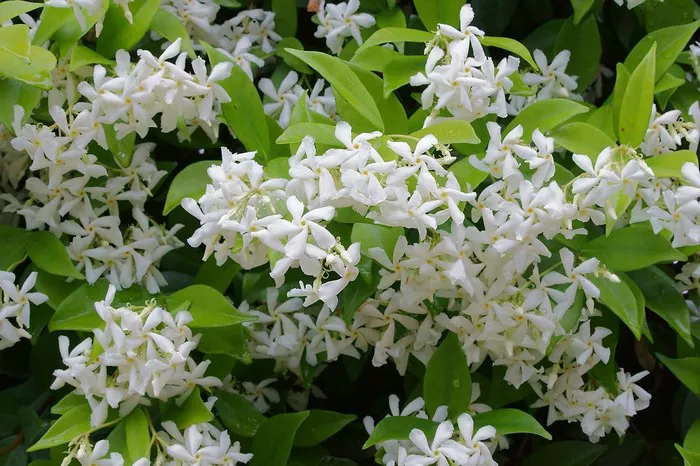In the realm of gardening and landscaping, the star jasmine plant, scientifically known as Trachelospermum jasminoides, stands out as a popular choice for its fragrant and delicate white flowers. However, for those considering adding this charming plant to their outdoor spaces, a common question arises: How long do star jasmine flowers last? Understanding the lifespan of these blossoms is crucial for garden enthusiasts and professionals alike. In this comprehensive article, we delve into the intricate details surrounding the longevity of star jasmine flowers, exploring factors that influence their bloom duration and offering insights to maximize their beauty in your garden.
Exploring the Life Cycle of Star Jasmine Flowers:
Star jasmine, native to China and Japan, boasts clusters of small, star-shaped white flowers that emit a sweet, intoxicating fragrance. These blooms typically appear in late spring to early summer, carpeting the vines with a stunning display of white petals against glossy green foliage. The duration of the flowering period largely depends on various environmental factors, plant health, and maintenance practices.
Environmental Factors:
Temperature, sunlight, and moisture levels play pivotal roles in determining the lifespan of star jasmine flowers. In regions with mild climates and consistent temperatures, the flowering period tends to be more prolonged compared to areas with extreme weather fluctuations. Adequate sunlight exposure, preferably in partial shade to full sun conditions, promotes healthy growth and enhances the longevity of blooms. Additionally, maintaining optimal soil moisture without overwatering or allowing it to become waterlogged is crucial for sustaining flower production.
Plant Health and Maintenance:
The overall health of the star jasmine plant significantly impacts the duration and abundance of its flowers. Proper planting techniques, soil preparation, and regular fertilization contribute to vigorous growth and robust blooming. Pruning is another essential aspect of maintenance, as it helps remove dead or damaged foliage, encourages new growth, and stimulates flower production. However, excessive pruning or improper timing can disrupt the natural blooming cycle and diminish flower longevity.
Understanding the Bloom Cycle:
The blooming cycle of star jasmine flowers follows a predictable pattern, beginning with bud formation, followed by flowering, and culminating in seed production. Bud formation typically occurs in early spring, heralding the imminent arrival of blossoms. As temperatures warm and daylight hours increase, the buds gradually unfurl into exquisite white flowers, releasing their captivating fragrance to attract pollinators. Once pollinated, the flowers give way to seed pods, signaling the end of the blooming phase.
Factors Influencing Flower Longevity:
While star jasmine flowers possess inherent beauty and resilience, several factors can influence their longevity and overall vibrancy. These include:
1. Environmental Stressors: Exposure to harsh environmental conditions such as extreme temperatures, drought, or excessive moisture can shorten the lifespan of star jasmine flowers.
2. Pest and Disease Management: Infestations of pests or diseases, if left unchecked, can damage foliage and compromise flower production, reducing the duration of blooming.
3. Nutrient Deficiencies: Inadequate soil nutrition or imbalances in essential nutrients can affect the plant’s health and vitality, impacting the longevity of its flowers.
4. Pruning Practices: Improper pruning techniques or excessive removal of flower-bearing stems can disrupt the natural blooming cycle and diminish the lifespan of star jasmine flowers.
Prolonging Flowering Period:
While the natural lifespan of star jasmine flowers is finite, gardeners can employ various strategies to extend the duration of blooming and maximize floral beauty:
1. Adequate Watering: Maintain consistent soil moisture levels by watering the plant deeply but infrequently, ensuring thorough saturation without waterlogging.
2. Mulching: Apply a layer of organic mulch around the base of the plant to conserve moisture, regulate soil temperature, and suppress weed growth, fostering optimal conditions for prolonged flowering.
3. Fertilization: Provide the star jasmine plant with a balanced fertilizer formulated for flowering vines to promote healthy growth and sustained flower production.
4. Pest and Disease Control: Implement proactive measures to prevent pest infestations and fungal diseases, such as regular inspection, cultural practices, and targeted treatments as needed.
5. Pruning Techniques: Adopt proper pruning techniques to remove spent flowers, deadwood, and excess foliage, promoting airflow, light penetration, and continuous blooming throughout the growing season.
Conclusion
The lifespan of star jasmine flowers is influenced by a myriad of factors, including environmental conditions, plant health, and maintenance practices. While the natural blooming period occurs in late spring to early summer, gardeners can prolong the duration of floral display through strategic care and attention. By understanding the intricacies of the bloom cycle and implementing effective gardening techniques, enthusiasts can enjoy the beauty and fragrance of star jasmine flowers for an extended period, adding a touch of elegance to their outdoor landscapes.


